Volcano-monitoring technology has revolutionized the way we predict and prepare for volcanic eruptions. By detecting subtle changes in gas emissions and seismic activity, scientists can provide early warnings to communities at risk.
This technology is crucial in saving lives and reducing the impact of volcanic eruptions on the surrounding environment. With the ability to detect tiny earthquakes and changes in gas emissions, volcano monitoring systems can identify potential eruptions before they happen.
Key Takeaways
- Volcano-monitoring technology detects gas emissions and seismic activity to predict eruptions.
- Early warnings can be provided to communities at risk, saving lives and reducing impact.
- Subtle changes in volcanic activity can be detected using advanced monitoring systems.
- Volcano monitoring is crucial in reducing the impact of eruptions on the environment.
- Advanced technology helps scientists identify potential eruptions before they happen.
The Growing Threat of Volcanic Eruptions
The threat of volcanic eruptions is escalating, with far-reaching implications for both local ecosystems and global climate patterns. As the frequency and intensity of these natural disasters increase, it’s crucial to understand their impact on communities and the environment.
Global Volcanic Activity Statistics
There are approximately 1,500 potentially active volcanoes worldwide, with around 50 eruptions occurring each year. Global volcanic activity statistics reveal a concerning trend: the number of large-scale eruptions has been increasing over the past few decades.
Active Volcanoes Around the World
Some of the most notable active volcanoes are located in the Pacific Ring of Fire, which includes volcanoes in Indonesia, the Philippines, and Japan. These regions are prone to frequent eruptions due to their geological location.
Population Centers at Risk
Many population centers are situated near active volcanoes, putting millions of people at risk. Cities like Naples, Italy, and Seattle, USA, are examples of densely populated areas near volcanic regions.
Impact on Communities and Infrastructure
Volcanic eruptions can have devastating effects on communities and infrastructure. Historical cases, such as the eruption of Mount St. Helens in 1980, demonstrate the destructive power of these events.
Historical Destruction Cases
The 1991 eruption of Mount Pinatubo in the Philippines caused widespread destruction and displaced hundreds of thousands of people. Such events highlight the need for effective early warning systems.
Economic and Social Consequences
The economic and social consequences of volcanic eruptions can be severe, including loss of property, disruption of global air travel, and long-term environmental damage.
Understanding Volcanic Warning Signs
Understanding the warning signs of volcanic eruptions is crucial for timely evacuations and saving lives. Volcano monitoring technology has advanced significantly, enabling scientists to detect subtle changes in volcanic activity.
Pre-eruption Indicators Scientists Look For
Scientists monitor various indicators to predict an impending eruption. These include ground deformation and temperature changes.
Ground Deformation Patterns
Ground deformation refers to changes in the shape of the volcano, such as swelling or deflation, which can indicate movement of magma beneath the surface. Advanced radar technology helps in detecting these changes.
Temperature Changes and Thermal Anomalies
Temperature changes around the volcano can signal increased volcanic activity. Thermal anomalies, detected through satellite imagery, can indicate the movement of hot magma or gases.
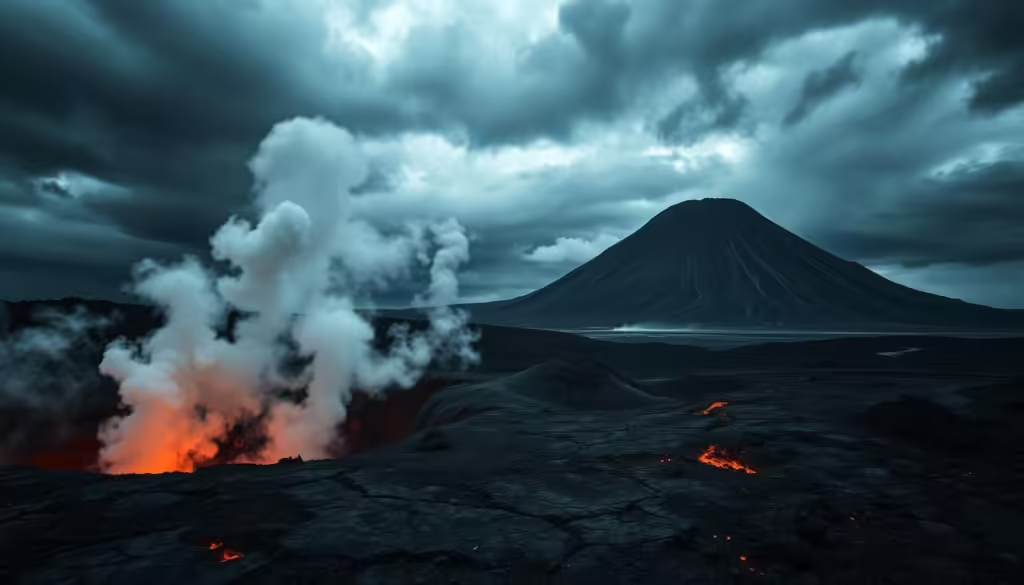
The Critical Timeframe for Evacuation
The timeframe for evacuation varies significantly depending on the volcano’s characteristics and the nature of the impending eruption.
Warning Window Variations by Volcano Type
Different types of volcanoes exhibit different warning signs and timeframes for eruption. For instance, stratovolcanoes may provide longer warning periods compared to shield volcanoes.
Evacuation Logistics and Challenges
Effective evacuation requires not only timely warnings but also well-planned logistics. Challenges include coordinating with emergency services, managing public response, and ensuring safe evacuation routes.
Evolution of Volcano Monitoring Technology
Over the years, volcano monitoring technology has undergone significant transformations, revolutionizing the field of volcanology. The ability to detect early warning signs of an impending eruption has become more precise, thanks to advancements in various monitoring techniques.
Historical Methods of Volcano Monitoring
In the past, volcano monitoring relied heavily on visual observations and simple measurements. Seismographs were among the earliest tools used to detect earthquakes associated with volcanic activity. “The development of seismographs in the early 20th century marked the beginning of a new era in volcano monitoring,” as noted by volcanologists. Historical methods laid the groundwork for the sophisticated technologies used today.
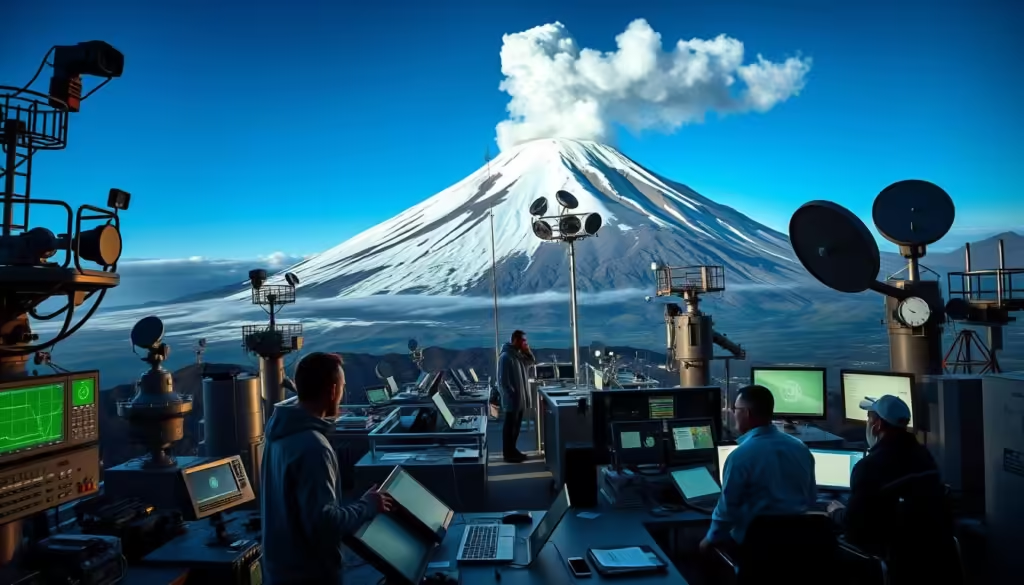
Technological Breakthroughs in Recent Decades
Recent decades have seen significant technological breakthroughs, including the use of satellite imagery and remote sensing technologies. These advancements have enabled scientists to monitor volcanic activity more effectively, even in remote areas. The integration of GPS technology has also improved the accuracy of ground deformation measurements, a critical indicator of volcanic activity.
Current State-of-the-Art Systems
Today, volcano monitoring systems are more complex and integrated, incorporating data from various sources, including seismic networks, gas emission monitoring, and satellite observations. “The current state-of-the-art systems represent a significant leap forward in our ability to predict volcanic eruptions,” according to experts. These systems are crucial for early warning systems that help protect communities near active volcanoes.
As climate change continues to impact global volcanic activity, the importance of advanced volcano monitoring technology cannot be overstated. Continued innovation in this field is vital for enhancing our understanding of volcanic processes and mitigating the risks associated with eruptions.
Gas Emission Detection Systems
Gas emission detection systems are at the forefront of volcanic eruption forecasting. These systems monitor the types and amounts of gases emitted by volcanoes, providing critical data for predicting eruptions.
How Volcanic Gases Signal Impending Eruptions
Volcanic gases, particularly sulfur dioxide (SO2) and carbon dioxide (CO2), are indicators of magma movement and potential eruptions. As magma ascends, it releases these gases, which can be detected and measured.
Sulfur Dioxide and Carbon Dioxide Significance
Sulfur dioxide is a key indicator of volcanic activity because it is released in significant amounts during eruptions. Carbon dioxide, on the other hand, is emitted in larger quantities over time and can signal the early stages of magma movement.
Remote Sensing Technologies for Gas Monitoring
Remote sensing technologies play a crucial role in gas emission detection. These include:
- Spectrometers that measure gas concentrations
- Infrared cameras that detect temperature changes associated with gas emissions
- Satellite-based systems that monitor gas plumes over wide areas
Spectrometers and Infrared Cameras
Spectrometers analyze the light absorbed or emitted by gases, allowing for the quantification of gas concentrations. Infrared cameras detect the thermal signatures of gas emissions, providing real-time data on volcanic activity.
Satellite-Based Gas Detection
Satellites equipped with spectrometers can detect gas emissions from space, offering a global perspective on volcanic activity. This technology is particularly useful for monitoring remote or inaccessible volcanoes.
Interpreting Gas Composition Data
Understanding the composition of volcanic gases is crucial for predicting eruptions. By analyzing the ratios of different gases, scientists can identify patterns that precede eruptions.
| Gas Ratio | Significance |
|---|---|
| SO2/CO2 | Indicates magma movement and potential eruption |
| CO2/H2O | Signals early stages of magma ascent |
Baseline Measurements vs. Anomalies
Establishing baseline measurements of gas emissions is essential for identifying anomalies that may signal an impending eruption. Deviations from these baselines can trigger alerts and further investigation.
Predictive Models Based on Gas Ratios
By analyzing gas ratios and other data, scientists develop predictive models that forecast the likelihood of an eruption. These models are refined over time as more data becomes available.
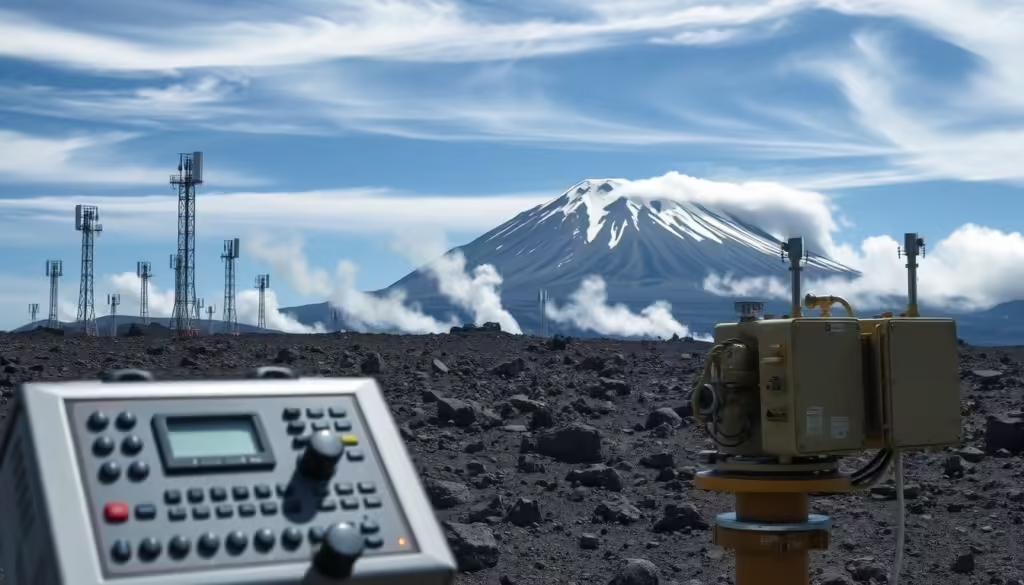
Seismic Monitoring Networks for Tiny Earthquakes
Advanced seismic monitoring systems are essential for providing early warnings to communities near active volcanoes. These systems detect tiny earthquakes, also known as microseismic activity, which can signal an impending eruption.
The Relationship Between Microseismic Activity and Eruptions
Microseismic activity is closely linked to volcanic eruptions. Scientists monitor this activity to understand the dynamics leading up to an eruption.
Volcanic Tremor Patterns
Volcanic tremors are continuous seismic signals that can indicate the movement of magma beneath a volcano. Analyzing these patterns helps scientists predict eruptions.
Earthquake Swarms as Warning Signs
An earthquake swarm, a series of small earthquakes occurring in a short period, can be a warning sign of an impending eruption. Seismic monitoring networks detect these swarms, providing critical data for early warnings.
Advanced Seismometer Technology
Modern seismometers are highly sensitive, capable of detecting even the smallest earthquakes. This technology is crucial for monitoring volcanic activity.
Broadband Seismic Stations
Broadband seismic stations provide a wide range of seismic data, helping scientists understand the complex dynamics of volcanic eruptions.
Borehole Instruments for Deeper Detection
Borehole instruments are placed deep within the earth’s crust, allowing for the detection of seismic activity that might not be visible on the surface.
Data Processing and Pattern Recognition
Advanced data processing techniques are used to analyze the vast amounts of data collected by seismic monitoring networks. Pattern recognition software helps identify potential warning signs.
Real-time Analysis Systems
Real-time analysis systems enable scientists to monitor seismic activity as it happens, providing timely warnings of potential eruptions.
Historical Pattern Comparison
By comparing current seismic data with historical patterns, scientists can better understand the likelihood of an eruption.
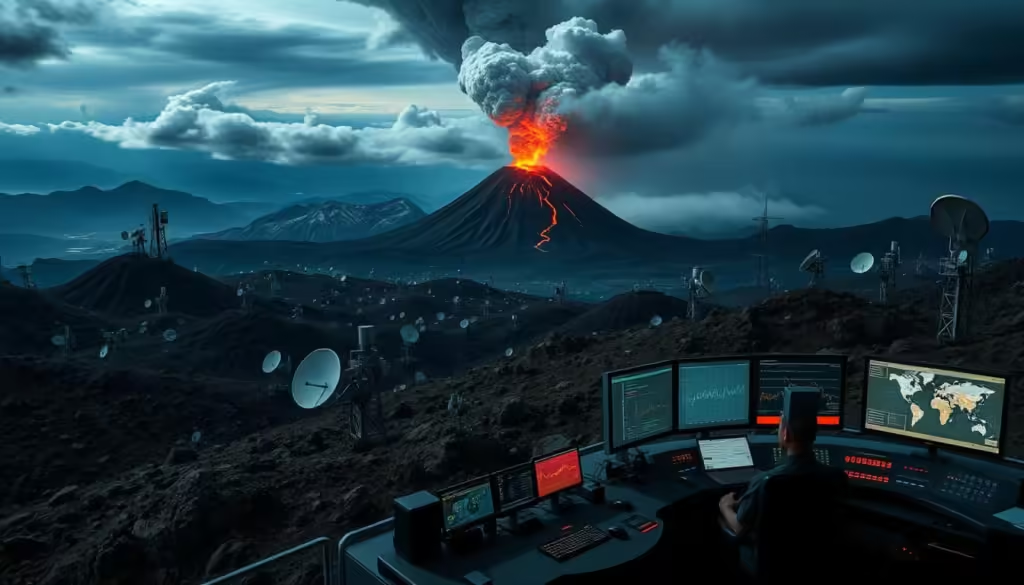
| Seismic Monitoring Aspect | Description | Importance |
|---|---|---|
| Microseismic Activity | Detection of tiny earthquakes | Early warning signs of eruption |
| Volcanic Tremor Patterns | Continuous seismic signals | Indicates magma movement |
| Earthquake Swarms | Series of small earthquakes | Warning sign of impending eruption |
Earth, Technology, and Climate Change: The Interconnected Monitoring Systems
As we navigate the complexities of volcanic eruptions, it becomes increasingly clear that the intersection of Earth processes, technology, and climate change is crucial to understanding the dynamics at play. The environment is a complex system where various factors interplay, and monitoring volcanic activity is not just about detecting earthquakes or gas emissions; it’s about understanding how these elements are influenced by broader climatic and environmental changes.
Integration of Multiple Data Sources
The effectiveness of volcanic eruption monitoring systems hinges on the integration of multiple data sources. By combining seismic data, gas emission rates, and other environmental indicators, scientists can gain a more comprehensive understanding of volcanic activity.
Centralized Monitoring Centers
Centralized monitoring centers play a crucial role in this integration, serving as hubs where data from various sources is collected, analyzed, and interpreted. This centralized approach enables quicker response times and more accurate decision-making.
Cross-validation of Warning Signals
Cross-validation of warning signals is another critical aspect. By comparing data from different monitoring systems, scientists can verify the accuracy of their predictions, reducing the likelihood of false alarms.
Climate Factors Affecting Volcanic Activity
Climate change is influencing volcanic activity in complex ways. Understanding these impacts is essential for improving the accuracy of eruption forecasts.
Glacial Melting Effects on Volcanic Systems
For instance, glacial melting can alter the stress on volcanic systems, potentially leading to changes in eruption frequency or intensity. “The reduction in glacier mass can lead to a decrease in pressure on the volcanic system, which may cause an eruption,” notes a recent study.
Atmospheric Conditions and Eruption Dynamics
Atmospheric conditions also play a significant role in eruption dynamics, affecting the dispersal of ash and gases. Understanding these conditions is vital for predicting the environmental impacts of an eruption.

Early Warning Systems in Action
The implementation of early warning systems has revolutionized the way we respond to volcanic eruptions. By leveraging advanced technology, communities near volcanoes can now receive timely warnings, potentially saving lives and reducing damage.
Case Study: Mount St. Helens Monitoring
Mount St. Helens is a prime example of the effectiveness of early warning systems. The 1980 eruption was catastrophic, but since then, significant advancements have been made in monitoring technology.
Technological Evolution Since 1980
Since the 1980 eruption, the monitoring technology around Mount St. Helens has evolved significantly, incorporating new methods such as seismic monitoring and gas emission detection.
Recent Prediction Successes
Recent years have seen successful predictions of smaller-scale events around Mount St. Helens, demonstrating the capability of modern early warning systems.
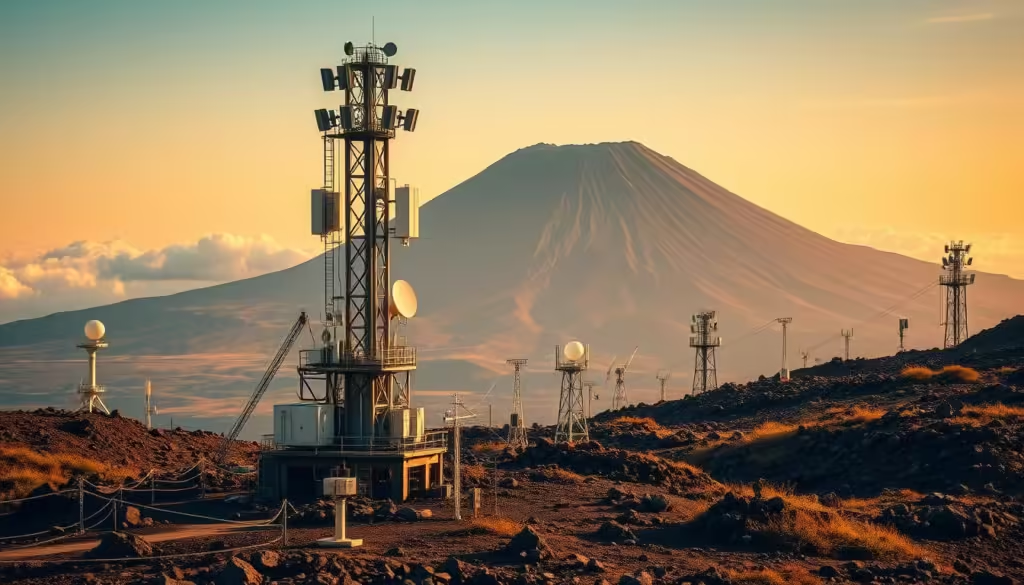
Case Study: Icelandic Volcano Network
Iceland’s volcanic landscape is home to a sophisticated monitoring network. This system has been crucial in managing the risks associated with volcanic activity, particularly for aviation.
Aviation Safety Improvements
The Icelandic Volcano Network has significantly improved aviation safety by providing timely warnings of ash clouds, thus preventing potential disasters.
Community Protection Measures
Beyond aviation safety, the network also protects local communities by providing early warnings for potential eruptions, allowing for evacuations and other safety measures.
Case Study: Japanese Volcanic Alert System
Japan’s volcanic alert system is another exemplary model of early warning systems in action. It integrates multiple data sources to provide comprehensive warnings.
Integration with Tsunami Warning Networks
One of the key features of Japan’s system is its integration with tsunami warning networks, recognizing the potential for volcanic eruptions to trigger tsunamis.
Public Response Protocols
The system also includes well-defined public response protocols, ensuring that warnings are communicated effectively to the public and that appropriate actions are taken.
These case studies demonstrate the critical role that early warning systems play in mitigating the impact of volcanic eruptions. By continuing to advance these systems, we can better protect communities and infrastructure around the world.
From Data to Decisions: How Warnings Reach Communities
When a volcano is about to erupt, the data collected by monitoring systems must be quickly translated into actionable warnings for nearby communities. This process involves several critical steps, from establishing alert levels to coordinating with emergency responders.
Alert Levels and Communication Protocols
Alert levels are a crucial component of volcano warning systems, providing a standardized way to communicate the level of threat. For instance, the United States Geological Survey (USGS) uses a color-coded system to indicate the level of alert, ranging from green (normal) to red (eruption in progress). Effective communication protocols ensure that the right information reaches the right people at the right time.
Government and Emergency Response Coordination
Coordination between government agencies and emergency responders is vital for effective disaster management. This includes sharing data, planning evacuation routes, and conducting regular drills. As “The key to successful emergency response is preparation and coordination.” A well-coordinated response can significantly reduce the risk to people and infrastructure.
Public Education and Preparedness
Public education plays a significant role in preparing communities for potential volcanic eruptions. This includes educating the public on the risks, the meaning of different alert levels, and the actions to take during an eruption. Community drills and training programs are essential for ensuring that the public knows how to respond.
Community Drills and Training
Regular community drills help to ensure that residents are prepared for an eruption. These drills can include evacuation procedures and information on how to protect oneself from ash fall.
Digital Alert Systems and Apps
Digital alert systems and mobile apps provide a direct way to inform the public of impending dangers. These systems can send real-time alerts to people’s phones, providing critical information and instructions during an emergency.
“The use of technology in disaster management has revolutionized the way we respond to natural hazards,” said Dr. Jane Smith, a volcanologist at the USGS. “With advanced warning systems, we can save lives and reduce the impact of volcanic eruptions.”
Challenges in Volcano Monitoring Technology
The effectiveness of volcano monitoring systems is hampered by various technical, geographical, and financial challenges. These challenges can significantly impact the ability of monitoring systems to provide early warnings to communities at risk.
Technical Limitations and False Alarms
Technical limitations, including the accuracy of gas emission detection and seismic monitoring systems, can lead to false alarms. False alarms not only waste resources but also erode public trust in the monitoring systems.
Remote and Difficult Terrain Issues
Many volcanoes are located in remote and difficult-to-access terrains, making the installation and maintenance of monitoring equipment challenging. This can lead to gaps in data collection and reduced system reliability.
Funding and Maintenance Challenges
Adequate funding is crucial for the establishment and ongoing maintenance of volcano monitoring systems. However, securing consistent funding can be difficult, especially for volcanoes that are not frequently active.
Cost-Benefit Analysis of Monitoring Systems
Conducting a thorough cost-benefit analysis is essential to justify the investment in volcano monitoring technology. This involves weighing the costs of system installation and maintenance against the potential benefits of early warnings and reduced risk.
International Cooperation and Resource Sharing
International cooperation and resource sharing can play a significant role in overcoming some of the challenges faced by volcano monitoring systems. Collaborative efforts can help in sharing technological advancements, best practices, and financial burdens.
| Challenge | Description | Potential Solution |
|---|---|---|
| Technical Limitations | Inaccuracy in gas emission detection and seismic monitoring | Advancements in sensor technology |
| Remote Terrain | Difficulty in accessing volcanoes for equipment installation and maintenance | Use of drones and satellite technology |
| Funding Challenges | Insufficient funds for system maintenance and upgrades | International cooperation and resource sharing |
The Future of Volcano Monitoring: Green Tech and Sustainability
Emerging trends in green tech are set to transform volcano monitoring, making it more sustainable and effective. As the world grapples with the challenges of climate change and environmental sustainability, the field of volcano monitoring is also evolving to incorporate greener technologies and practices.
AI and Machine Learning Applications
The integration of AI and machine learning is revolutionizing volcano monitoring. These technologies enable the analysis of vast amounts of data from various sources, improving the accuracy of eruption predictions.
Predictive Algorithm Development
Advanced algorithms can now predict volcanic eruptions with greater precision, allowing for timely evacuations and minimizing the impact on communities.
Automated Alert Generation
Automated systems can generate alerts in real-time, ensuring that authorities and the public are informed promptly about potential eruptions.
Sustainable Power Solutions for Remote Monitoring Stations
Remote monitoring stations are crucial for volcano surveillance, and sustainable power solutions are being adopted to ensure their continued operation.
Solar and Wind Integration
The use of solar and wind power is becoming increasingly common, reducing reliance on fossil fuels and minimizing the carbon footprint of monitoring stations.
Geothermal Power Utilization
In some cases, geothermal power is being harnessed to provide energy for monitoring equipment, offering a sustainable and reliable source of power.
Satellite and Drone Integration
Satellites and drones are being integrated into volcano monitoring systems, providing high-resolution imagery and real-time data.
High-Resolution Imaging Advances
Advances in satellite and drone technology have enabled the capture of high-resolution images, aiding in the detection of early warning signs of eruptions.
Autonomous Monitoring Vehicles
Autonomous vehicles are being developed to monitor volcanic activity in real-time, enhancing the safety and efficiency of monitoring operations.
| Technology | Application | Benefits |
|---|---|---|
| AI and Machine Learning | Predictive modeling and alert generation | Improved accuracy and timely warnings |
| Sustainable Power | Renewable energy for remote stations | Reduced carbon footprint and reliable power |
| Satellites and Drones | High-resolution imaging and monitoring | Enhanced surveillance and early detection |
Conclusion: Safeguarding Communities Through Advanced Monitoring
Advanced volcano monitoring technology plays a vital role in safeguarding communities from the devastating impact of volcanic eruptions. By detecting gas emissions and tiny earthquakes, these systems provide early warnings that can save lives and protect infrastructure.
The integration of Earth observation data and cutting-edge Technology has significantly enhanced our ability to predict volcanic activity. As we continue to invest in advanced monitoring systems, we can better prepare communities for potential eruptions, reducing the risk of damage and loss.
Effective safeguarding of communities requires continued innovation and investment in volcano monitoring Technology. By doing so, we can ensure that communities are equipped with the necessary tools and knowledge to respond to volcanic activity, ultimately saving lives and reducing the economic impact of eruptions.
FAQ
What is volcano monitoring technology?
Volcano monitoring technology refers to the various methods and tools used to track and predict volcanic activity, including gas emissions, earthquakes, and ground deformation.
How do gas emissions signal an impending eruption?
Changes in gas emissions, such as increases in sulfur dioxide and carbon dioxide, can indicate magma movement and pressure buildup, signaling a potential eruption.
What is seismic monitoring, and how does it help predict eruptions?
Seismic monitoring involves detecting and analyzing earthquakes and tremors around a volcano. This helps scientists understand the movement of magma and fluids beneath the surface, which can indicate an impending eruption.
How do early warning systems work?
Early warning systems use data from monitoring technologies, such as seismic and gas emission monitoring, to detect signs of an impending eruption. This information is then used to alert authorities and communities at risk.
What are some challenges in volcano monitoring?
Challenges include technical limitations, remote and difficult terrain, funding constraints, and the need for international cooperation and resource sharing.
How can AI and machine learning improve volcano monitoring?
AI and machine learning can enhance predictive capabilities by analyzing large datasets, identifying patterns, and generating automated alerts, allowing for more timely and accurate warnings.
What role does climate change play in volcanic activity?
Climate change can affect volcanic activity through glacial melting, changes in atmospheric conditions, and other factors, which can influence eruption dynamics and the likelihood of an eruption.
How are volcano monitoring data used to protect communities?
Data from volcano monitoring are used to inform alert levels, evacuation decisions, and emergency response planning, ultimately helping to safeguard communities at risk.

